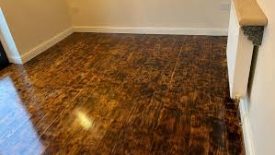Burnt oriented strand board (OSB) flooring is a unique and trendy flooring option that can transform the look of your home. OSB is a type of engineered wood made from strands of wood that are arranged in layers and bonded together with resin. Burnt OSB flooring is created by charring the surface of the OSB with fire, resulting in a dramatic and rustic look that can add character and warmth to any room. In this article, we will discuss the benefits and drawbacks of burnt OSB flooring and provide tips on how to install and maintain this type of flooring.
Benefits of Burnt OSB Flooring:
- Unique Look: Burnt OSB flooring has a one-of-a-kind appearance that cannot be replicated by any other type of flooring. The charring process creates a distinctive pattern of black and brown colors that can add texture and depth to any room.
- Cost-Effective: Burnt OSB flooring is an affordable flooring option that is much less expensive than hardwood or tile flooring. This makes it an attractive option for homeowners on a budget who still want to achieve a high-end look in their home.
- Easy to Install: Burnt OSB floor is relatively easy to install, especially for those with basic carpentry skills. It can install as a floating floor or glued down to the subfloor, and can cut to fit any room size or shape.
- Durable: OSB is a strong and durable material that can withstand heavy foot traffic and daily wear and tear. The charring process can also increase the durability of the flooring by making it more resistant to moisture and insects.
- Eco-Friendly: OSB is an environmentally friendly flooring option because it is made from fast-growing trees that easily replenish. Additionally, the charring process uses fire as a natural preservative, eliminating the need for toxic chemicals or treatments.
Drawbacks of Burnt OSB Flooring:
- Limited Availability: Burnt OSB floor is not widely available at home improvement stores, and may require special ordering or custom fabrication. This can make it difficult to find and more expensive to purchase.
- Requires Maintenance: Burnt OSB floor requires regular maintenance to keep it looking its best. The charring process can make the surface of the flooring rough and prone to splintering, so it may need to sanded and refinished periodically.
- Not Suitable for Moisture-Prone Areas: OSB is a moisture-prone material that can warp or swell if exposed to water or humidity. Therefore, burnt OSB floor may not be suitable for use in areas such as bathrooms or kitchens, where moisture levels are high.
Tips for Installing Burnt OSB Flooring:
- Prepare the Subfloor: Before installing burnt OSB floor, ensure that the subfloor is clean, level, and dry. If necessary, repair any cracks or uneven spots in the subfloor to ensure a smooth and stable surface for the flooring.
- Acclimate the Flooring: Allow the burnt OSB floor to acclimate to the room’s temperature and humidity levels for at least 48 hours before installation. This will prevent the flooring from warping or buckling after installation.
- Choose the Right Installation Method: Burnt OSB floor can install as a floating floor or glued down to the subfloor. The best method will depend on the room’s size, shape, and layout, as well as your personal preference.
- Use a Moisture Barrier: To prevent moisture from seeping into the flooring, use a moisture barrier between the subfloor and the burnt OSB floor.
- Install Quarter Round Molding: Install quarter round molding around the perimeter of the room to cover the expansion gap between the flooring and the walls. This will create a finished and polished look.
Tips for Maintaining Burnt OSB Floor:
- Clean Regularly: To keep your burnt OSB flooring looking its best, clean it regularly with a vacuum or a broom. Avoid using water or steam cleaners, as these can damage the flooring’s surface.
- Sand and Refinish: If the burnt OSB flooring becomes rough or splintered, sand it down and refinish it to restore its smooth surface. Use a fine-grit sandpaper to avoid damaging the charring pattern.
- Seal the Floor: To protect the burnt OSB floor from moisture and stains, consider applying a sealer to the surface. This will help to maintain the flooring’s appearance and increase its longevity.
- Avoid Scratches and Dents: Burnt OSB floor can be prone to scratches and dents, so take care when moving heavy furniture or objects across the floor. Consider using furniture pads or coasters to prevent scratches and dents from occurring.
- Address Moisture Issues: If you notice any signs of moisture damage, such as warping or buckling, address the issue immediately to prevent further damage. This may involve repairing leaks, increasing ventilation, or installing a dehumidifier in the room.
Conclusion:
Burnt OSB flooring is a unique and affordable flooring option that can add character and warmth to any room. While it does require some maintenance and may not be suitable for moisture-prone areas, the benefits of burnt OSB flooring, including its unique appearance, affordability, and durability, make it an attractive option for many homeowners. By following the tips for installation and maintenance outlined in this article, you can enjoy the beauty and functionality of burnt OSB flooring in your home for years to come.

